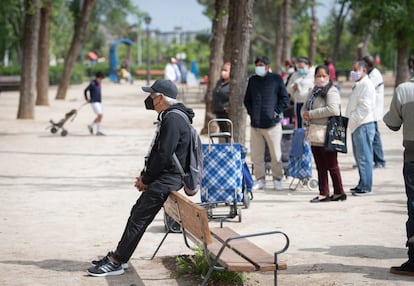Coronavirus pandemic pushed poverty in Spain to highest levels since the Great Recession
According to a survey from the National Statistics Institute, 7% of Spaniards were suffering severe material deprivation by the end of last year

Poverty and inequality were gradually being corrected in Spain after the devastating effects of the Great Recession that began in 2008. But the arrival of the coronavirus pandemic, and the economic effects it has had due to the restrictions that were put in place, have meant a serious setback to this progress. Severe poverty or material deprivation affected 7% of the population in 2020, around 3.3 million people. That’s according to the Living Conditions Survey published on Thursday by the National Statistics Institute (INE).
The figure is much higher than the 4.7% registered in 2019, and is slightly below the 7.1% seen in 2014, which was the worst moment of the financial crisis. Public mechanisms such as the government’s ERTE furlough scheme and family help have provided a significant buffer, stopping these numbers from being even worse given the drastic paralysis of activity.
Unlike other data that appear in the Living Conditions Survey, which are based on income figures from 2019, the indicator of severe material deprivation is based on a survey. According to the INE survey, which collected data in the fourth quarter of 2020, reflecting the situation at the end of the first year of the pandemic, 3.3 million people in Spain were at the time facing a severe lack of necessary items.
The regions where respondents said they had the most difficulty getting to the end of the month in 2020 were the Canary Islands, Andalusia and Extremadura
This is understood as lacking up to four necessities from a list of nine, including: serious difficulties to get to the end of the month with enough money (10%, up three points from the previous year); an inability to deal with unexpected expenses (35.4%, nearly two points up); delays in making payments on the main residence or on instalment plans (13.5%, double the figure for 2019); an inability to go on a week’s vacation a year (34.4%, one point up); an inability to maintain an adequate temperature in the home (10.9%, compared to 7.6% in 2019); an inability to afford a meal with meat or fish every two days (5.4% compared to 3.8%); an inability to afford a car, phone, television or washing machine.
The regions where respondents said they had the most difficulty getting to the end of the month in 2020 were the Canary Islands (15.6% of respondents), Andalusia (14.8%) and Extremadura (12.7%). The regions with the lowest percentages were Aragón (5.5%), the Basque Country (5.6%) and Navarre (5.9%).
The data reflect what was seen in the so-called “hunger lines” during the pandemic, when many Spanish citizens were forced to resort to handouts in order to eat. The figures reflect a precarious situation in households, but they do not supply enough information to indicate the levels of destitution, which is the most extreme form of poverty.
In terms of the impact that the pandemic has had on inequality, the figures published on Thursday refer to 2019, and as such do not reflect any changes from the pandemic. To date, there has only been some preliminary research carried out by the Bank of Spain and that confirm a sharp rise. According to these figures, 10% of the highest earners went from earning five times what the poorest 10% earn to 18 times during the first wave of the coronavirus pandemic. When the recovery seen in the third quarter of last year arrived, the figure fell to eight times – still a very sharp contrast, however.
Inequality can be seen in other data supplied by the INE. The contrast is huge: while one in 10 Spanish households had difficulties getting to the end of the month, 19.6% of households said in 2020 that they could maintain the same standard of living for more than 12 months just with their savings.
Another indicator is the risk of poverty or social exclusion, the so-called AROPE rate designed by the European Commission. According to data from 2019, 26.4% of Spanish citizens were at risk of poverty, a figure that exceeded the 25.3% from the previous survey. Does that mean that one in four people is poor? Not exactly.
This statistic is based on individuals whose disposable income is below 60 % of the national median, and adjusted according to the composition of their household (in 2019, this level was €9,626 for single-person households and €20,215 for families with two adults and two children). In 2018, 20.7% were below this threshold. And in 2019 the figure was 21%, despite a major rise in the minimum wage being approved that year. What’s more, families in severe poverty must be included – 7% based on 2020 data, as well as those whose members work very few hours, which came in at 9.9% in 2019 compared to 10.8% the previous year. By combining these three groups, the population at risk of poverty rises to 26.4% of the total. In reality, this is more an indicator of inequality than poverty itself, meaning that Spain is facing the challenge of correcting this inequality of income.
The INE points to the fact that the risk of poverty is greater in the population with lower academic qualifications and in families made up of one adult with dependent children. Nearly 50% of people living in a household with one adult and children is at risk of poverty or social exclusion, according to the data.
Unemployment is the biggest cause of the risk of exclusion. As would be expected, those working have a much lower risk of poverty than the unemployed: 15% compared to 54.7%, respectively. The retired, meanwhile, are at a similar risk of poverty as the employed, at 16.7%.
English version by Simon Hunter.
Tu suscripción se está usando en otro dispositivo
¿Quieres añadir otro usuario a tu suscripción?
Si continúas leyendo en este dispositivo, no se podrá leer en el otro.
FlechaTu suscripción se está usando en otro dispositivo y solo puedes acceder a EL PAÍS desde un dispositivo a la vez.
Si quieres compartir tu cuenta, cambia tu suscripción a la modalidad Premium, así podrás añadir otro usuario. Cada uno accederá con su propia cuenta de email, lo que os permitirá personalizar vuestra experiencia en EL PAÍS.
¿Tienes una suscripción de empresa? Accede aquí para contratar más cuentas.
En el caso de no saber quién está usando tu cuenta, te recomendamos cambiar tu contraseña aquí.
Si decides continuar compartiendo tu cuenta, este mensaje se mostrará en tu dispositivo y en el de la otra persona que está usando tu cuenta de forma indefinida, afectando a tu experiencia de lectura. Puedes consultar aquí los términos y condiciones de la suscripción digital.
More information
Últimas noticias
Welcome to the post-religion era: The idea of Christianity as the absolute truth has become obsolete
‘I thought you would like it’: The risky sexual practice popularized by TV shows and TikTok
The digitalization of tourism: ‘They promise experiences and gave us the worst possible one’
Mexican peso defies uncertainty with forecasts of a new period of stability in 2026
Most viewed
- Sinaloa Cartel war is taking its toll on Los Chapitos
- Oona Chaplin: ‘I told James Cameron that I was living in a treehouse and starting a permaculture project with a friend’
- Reinhard Genzel, Nobel laureate in physics: ‘One-minute videos will never give you the truth’
- Why the price of coffee has skyrocketed: from Brazilian plantations to specialty coffee houses
- Silver prices are going crazy: This is what’s fueling the rally











































